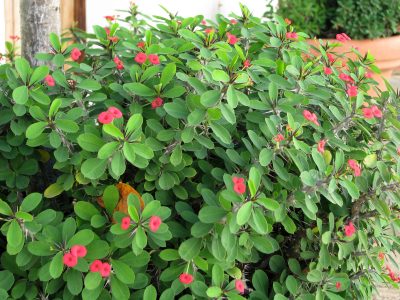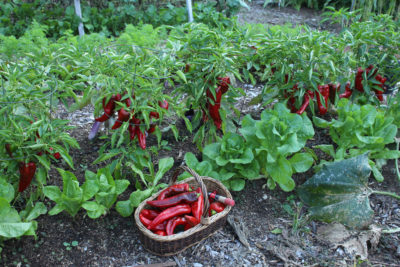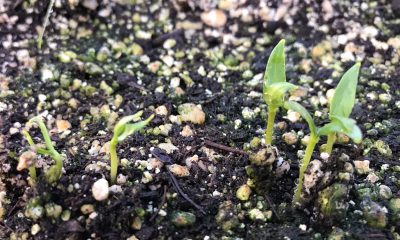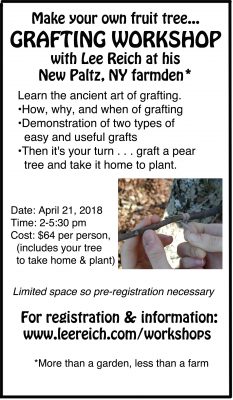Spring Inspires
/0 Comments/in Gardening, Houseplants/by Lee ReichEven Bob Got the Bug
As I write, daily high temperatures are in the 30s and snow is predicted. Nonetheless, just a few warm, sunny days and almost everyone is going to be inspired to garden. Or at least do something plantwise. Even my friend Bob.
Bob’s non-interest in gardening was demonstrated decades ago as I was starting my first very own garden at a house I was renting. Bob was there as I pushed my shovel into the clay soil of the lawn to turn over spadeful after spadeful. Bob watched peacefully lying beyond the proposed plot with his head propped up on his hands. (Not so another friend, Hans, who grabbed another shovel, and dug. Now that I think of it, perhaps I owned only two shovels.)

A crown of thorns (not Bob’s)
Bob’s current interest centers around one plant, a potted crown of thorns plant (Euphorbia milii). Crown of thorns is very easy to grow because it’s a succulent. Like other succulents, crown of thorns can store water, in this case in both its thick stems and its fleshy leaves.
The stems, armed with stout thorns, are what give crown of thorns its common name. Legend has it that this plant was woven into the crown of thorns worn by Jesus. Although the plant is native to Madagascar, it had made its way to the Middle East by the time of Christ. But it probably was not the plant that made his crown of thorns.
I once had a crown of thorns plant, and, unlike Bob, with his plant, pretty much ignored it as far as care. Mine flowered occasionally, which was enough because I had a lot of other plants to entertain me. Bob, on the other hand, is becoming a crown of thorns maven, tweaking conditions to try to eke the most and best blooms from his one plant. We go back and forth on how much light they need (the more the better) and how frequently to water (I suggest infrequent but deep watering). The final word has not been said.
Differences of opinion may be traced to differences of plants. Crown of thorns became a popular plant in the 1970s and new varieties were being offered, among them hybrids between E. milii and E. lophogona. The latter species have long, leathery leaves and flower more freely than the former. Some varieties of these hybrids had stouter stems and thinner leaves; others had thinner stems and thicker leaves. Flower sizes increased and a range of shades, from white to pink to red, became available.
Not all hybrid crown of thorns plants enjoy the same growing conditions. Some of the hybrids prefer their soil consistently moist rather than cycling between bone dry and wet. More light is generally better for more flowers although some plants need long nights without any light at all for best flowering.
In a few weeks Bob is going to prune his plant so I’ll get a few cuttings to make plants of my own. The cuttings root in a month or two if their cut ends are dipped in cold water to prevent excess loss of the white sap, slid into a well drained mix, such as peat and perlite, and kept slightly moist.
Horticultural Evolution
So Bob has horticulturally evolved to lavish care on his one plant. He’s busy repotting it this time of year.
I’ve also horticulturally evolved. I would no longer begin a garden by turning over shovelful after shovelful of soil. Nowadays my method is to smother lawn grass beneath wetted paper topped with compost for planting areas and wood chips for paths, which avoids two problems with that first planting: having to wait a couple of weeks before planting, and then having to deal with the sea of quack grass and other weeds that result from turning over the soil. More details on this in my book Weedless Gardening.
Peppers & Potting Soil
/5 Comments/in Gardening, Soil, Vegetables/by Lee ReichConcerned
You’d think that there’d be no reason for me to be concerned. After all, year after year I raise my own seedlings for the garden. Nonetheless, every day I take a look at the small tray of soil in which I had sowed eggplant and pepper seeds, waiting for little green sprouts to poke through the brown surface of the potting mix.
These plants are on a schedule. They get a start indoors — in a greenhouse now; under lights or in sunny windows in years past — so that they have enough time to start ripening their fruits by midsummer.

Italian Sweet peppers
Even an early-ripening pepper wouldn’t ripen its first fruits before October if seeds were sown directly in the garden once the soil had warmed enough for germination, which isn’t until the end of May around here.
Ingredients for Good Transplants
Not that raising transplants for the garden is difficult. All that’s needed is attention to details, the first of which is using seed that is not too old. The dry tan pepper and eggplant seeds might not look alive, but they are. And they do age. Under good storage condition — cool and dry — pepper seeds retain good viability for only a couple of years, eggplant seeds for 4 years.
Next in importance is the container and potting mix. Old yogurt containers, egg cartons — people have come up with all sorts of containers for growing transplants. They’re all fine as long as they’re at least an inch and a half deep and have holes in their bottoms to let excess water drain out.
Garden soil, even good garden soil, is not suitable for containers. It stays too wet, suffocating roots. So all potting mixes contain aggregates, such as sand, perlite, vermiculite, or calcined clay (a.k.a. kitty litter), which are large mineral particles that make room for air in the mix. Mixes also contain some organic material, such as compost, peat moss, or coir (made from coconut waste), to help them retain moisture.
You can purchase potting mixes made with or without real soil in them, and either sterilized or not. Sterilization kills potential pests that might lurk in the raw ingredients. Not sterilizing keeps living things, including potential enemies of any potential pests, alive in the mix. I make my own mix, usually unsterilized, from equal parts compost, garden soil, peat moss, and perlite.
With seeds sown and then covered with about a half inch of potting mix, the container is gently watered, then covered to keep in moisture.
Warmth is the next ingredient for good germination. Seeds need more warmth to sprout than than a seedling needs for good growth. In the case of pepper and eggplant seeds, between 70 and 80° F. is ideal for sprouting. The top of a refrigerator might provide a warm home for the seeds to get started, as might a shelf above a radiator. I use a soil heating mat.
The last ingredient in raising seedlings is the most difficult one for me to provide, at least with pepper and eggplant seeds. Patience. Even under good conditions, these seeds might take a week or two to sprout. All I need, then, is to be rational. I sowed the seed on March 5th; I provided good conditions. As I write this, it is March 12th. One week, a not unreasonable time for the seeds not to yet show signs of life.
Not to Worry
Growing transplants is generally easy. Although I’m a little concerned until pepper and eggplant sprouts emerge, I’m more laid back with pretty much all other seedlings. Tomatoes, for example, are among the quickest and easiest to grow, and, because of the wide choice of varieties when growing your own transplants, very satisfying.
Once the peppers and eggplants sprout, they, like other sprouts, need to be moved to where they are bathed in light. Along with light, slightly cooler temperatures from then on make for sturdy, healthy growth. And then, towards the end of May, out to the garden they go.
Update: March 17th. I was about to re-sow the pepper seeds. But first I checked the ones sowed March 5th. They sprouted!


